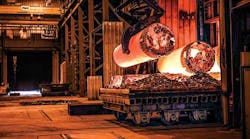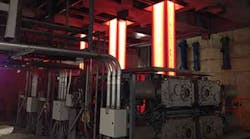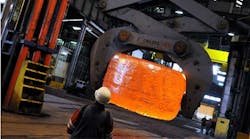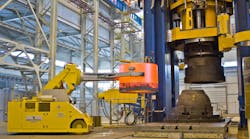Danieli’s Rotoforge technology adds a high productivity factor to the forge-rolling trend
The structural qualities of forged products are gaining wider appreciation in the design of finished parts, which is one reason that ‘forge-rolling’ techniques are being adopted by producers of engineered materials, like the steel bars that are used in multiple mechanical and structural programs. In September, Danieli inaugurated its Rotoforge technology at ABS, its wholly owned, engineered steel operation at Cargnacco, Italy. The output of this new process will be a class of high-tensile strength steel bars for energy sector, automotive, nuclear power, and oil-and-gas manufacturing.
Italian Prime Minister Matteo Renzi attended the ribbon-cutting ceremony for the newly designed Rf stand, which is the unit that converts high-quality blooms into densely formed rolling stock, comparable to forged products.
Prior to installing and inaugurating the Rf stand, Danieli revamped the ABS continuous bloom caster to produce material up to 850 mm round, the largest continuously cast blooms available in the world. The caster and the Rf stand were elements of the “Marte” project at ABS, which started in 2013 with the replacement of a reversing mill and the installation of a new blooming mill in 2014.
Rotoforge was conceived as a process to produce cast material with internal structural quality comparable to forged material, with improved size tolerances, a high reduction ratio (>1:3) across the entire product range, and capable of high-volume, short lead-time production.
Danieli’s concept involves a rolling stand capable of imparting the same material strain that is achieved by forging.
The process involves a high degree of drafting on each pass, such that Rotoforged material has a fine grain structure and low soundness (FBH < 2 mm), with excellent surface quality and high productivity typical of long-product rolling. As such, there is a significant reduction in transformation costs while no additional turning is required.
During Rotoforging, a bar is rotated at every pass (as in forging) to increase the isotropic grain characteristics of the final product.
To minimize the investment costs and speed ROI, ABS and Danieli installed the Rf stand upstream of two reversing stands. This led to a new challenge: a rolling mill with three 2-high stands. To achieve maximum flexibility in production, quick-change stands are used, as in SBQ rolling. The high reduction ratios needed to produce large rounds meant expanding the cross-section of the feedstock material. Thus, the con caster was revamped to cast blooms up to 850 mm diameter.
The final plant layout was developed to maximize operational flexibility: Cast blooms are heated at a rate of 100 mt/h in walking-beam furnace (hot charging from the caster is an option), and ingots are staged in a pit furnace directly ahead of the Rotoforge stand.
The three reversible stands are arranged for “cascade” rolling, each one finishing a set range of rounds (110-230 mm, 230-405 mm, 360-500 mm) and equivalent squares. The three stands ensure the best final product achievable in terms of quality and tolerances.
Rolling guides are designed to be removed together with the roll chocks through the stand housing, further reducing the time for roll changes. When operated in fully automatic mode, and connected to higher-level automation, the rolling process is able to use control algorithms that maintain steady and repeatable production of high-quality, high-tensile strength steel.













